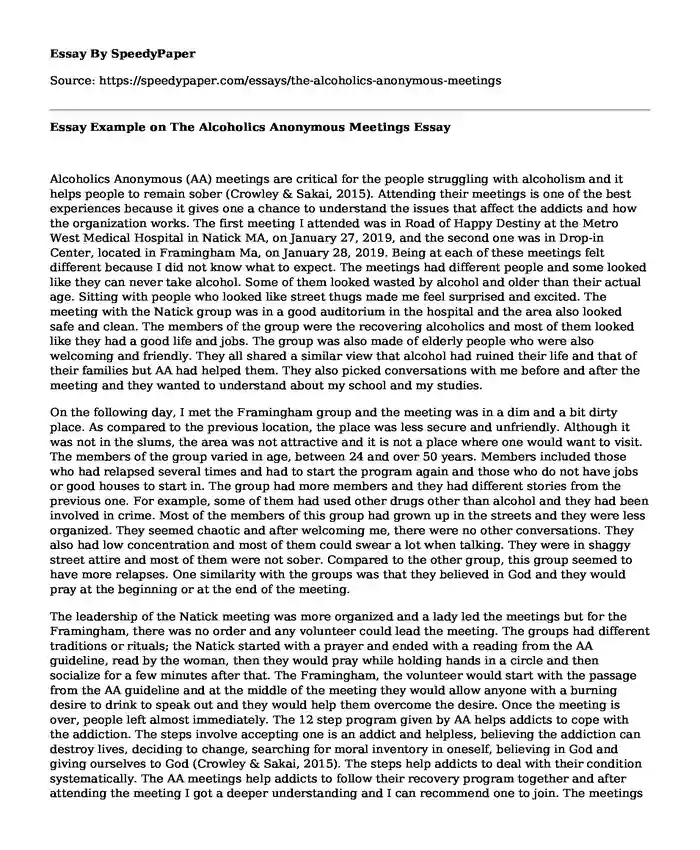Alcoholics Anonymous (AA) meetings are critical for the people struggling with alcoholism and it helps people to remain sober (Crowley & Sakai, 2015). Attending their meetings is one of the best experiences because it gives one a chance to understand the issues that affect the addicts and how the organization works. The first meeting I attended was in Road of Happy Destiny at the Metro West Medical Hospital in Natick MA, on January 27, 2019, and the second one was in Drop-in Center, located in Framingham Ma, on January 28, 2019. Being at each of these meetings felt different because I did not know what to expect. The meetings had different people and some looked like they can never take alcohol. Some of them looked wasted by alcohol and older than their actual age. Sitting with people who looked like street thugs made me feel surprised and excited. The meeting with the Natick group was in a good auditorium in the hospital and the area also looked safe and clean. The members of the group were the recovering alcoholics and most of them looked like they had a good life and jobs. The group was also made of elderly people who were also welcoming and friendly. They all shared a similar view that alcohol had ruined their life and that of their families but AA had helped them. They also picked conversations with me before and after the meeting and they wanted to understand about my school and my studies.
On the following day, I met the Framingham group and the meeting was in a dim and a bit dirty place. As compared to the previous location, the place was less secure and unfriendly. Although it was not in the slums, the area was not attractive and it is not a place where one would want to visit. The members of the group varied in age, between 24 and over 50 years. Members included those who had relapsed several times and had to start the program again and those who do not have jobs or good houses to start in. The group had more members and they had different stories from the previous one. For example, some of them had used other drugs other than alcohol and they had been involved in crime. Most of the members of this group had grown up in the streets and they were less organized. They seemed chaotic and after welcoming me, there were no other conversations. They also had low concentration and most of them could swear a lot when talking. They were in shaggy street attire and most of them were not sober. Compared to the other group, this group seemed to have more relapses. One similarity with the groups was that they believed in God and they would pray at the beginning or at the end of the meeting.
The leadership of the Natick meeting was more organized and a lady led the meetings but for the Framingham, there was no order and any volunteer could lead the meeting. The groups had different traditions or rituals; the Natick started with a prayer and ended with a reading from the AA guideline, read by the woman, then they would pray while holding hands in a circle and then socialize for a few minutes after that. The Framingham, the volunteer would start with the passage from the AA guideline and at the middle of the meeting they would allow anyone with a burning desire to drink to speak out and they would help them overcome the desire. Once the meeting is over, people left almost immediately. The 12 step program given by AA helps addicts to cope with the addiction. The steps involve accepting one is an addict and helpless, believing the addiction can destroy lives, deciding to change, searching for moral inventory in oneself, believing in God and giving ourselves to God (Crowley & Sakai, 2015). The steps help addicts to deal with their condition systematically. The AA meetings help addicts to follow their recovery program together and after attending the meeting I got a deeper understanding and I can recommend one to join. The meetings are efficient in dealing with the addiction. The meetings improved my perception about substance abuse and I now view addicts as victims that need help rather than criminals as I used to view them before.
References
Crowley, T. J., & Sakai, J. T. (2015). Substancerelated and addictive disorders. Rutter's Child and Adolescent Psychiatry, 931-949.
Cite this page
Essay Example on The Alcoholics Anonymous Meetings. (2022, Nov 08). Retrieved from https://speedypaper.net/essays/the-alcoholics-anonymous-meetings
Request Removal
If you are the original author of this essay and no longer wish to have it published on the SpeedyPaper website, please click below to request its removal:
- Solving Contemporary Ethical Issue. Free Essay.
- Drug Abuse, Free Essay for Everyone
- Essay Example: Facebook and the Regulations in Politics
- Essay Sample Describing Lifespan Human Motor Development
- Paper Example: Technologies and Scalability of Website
- Free Essay on Intercultural Communication in Singapore
- Paper Example. Corporate Portal Scorecard
Popular categories





